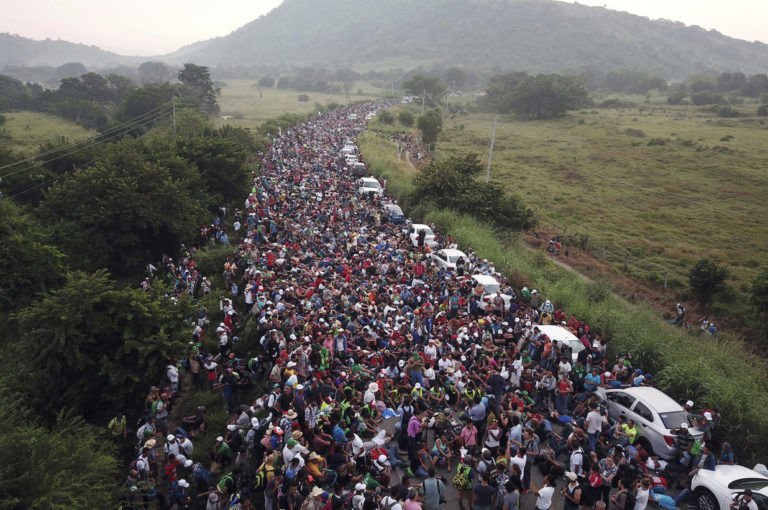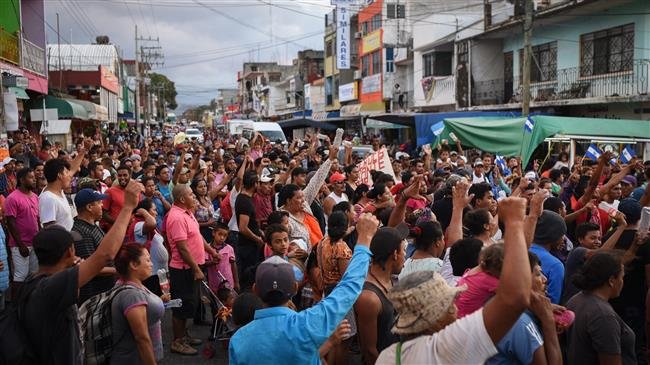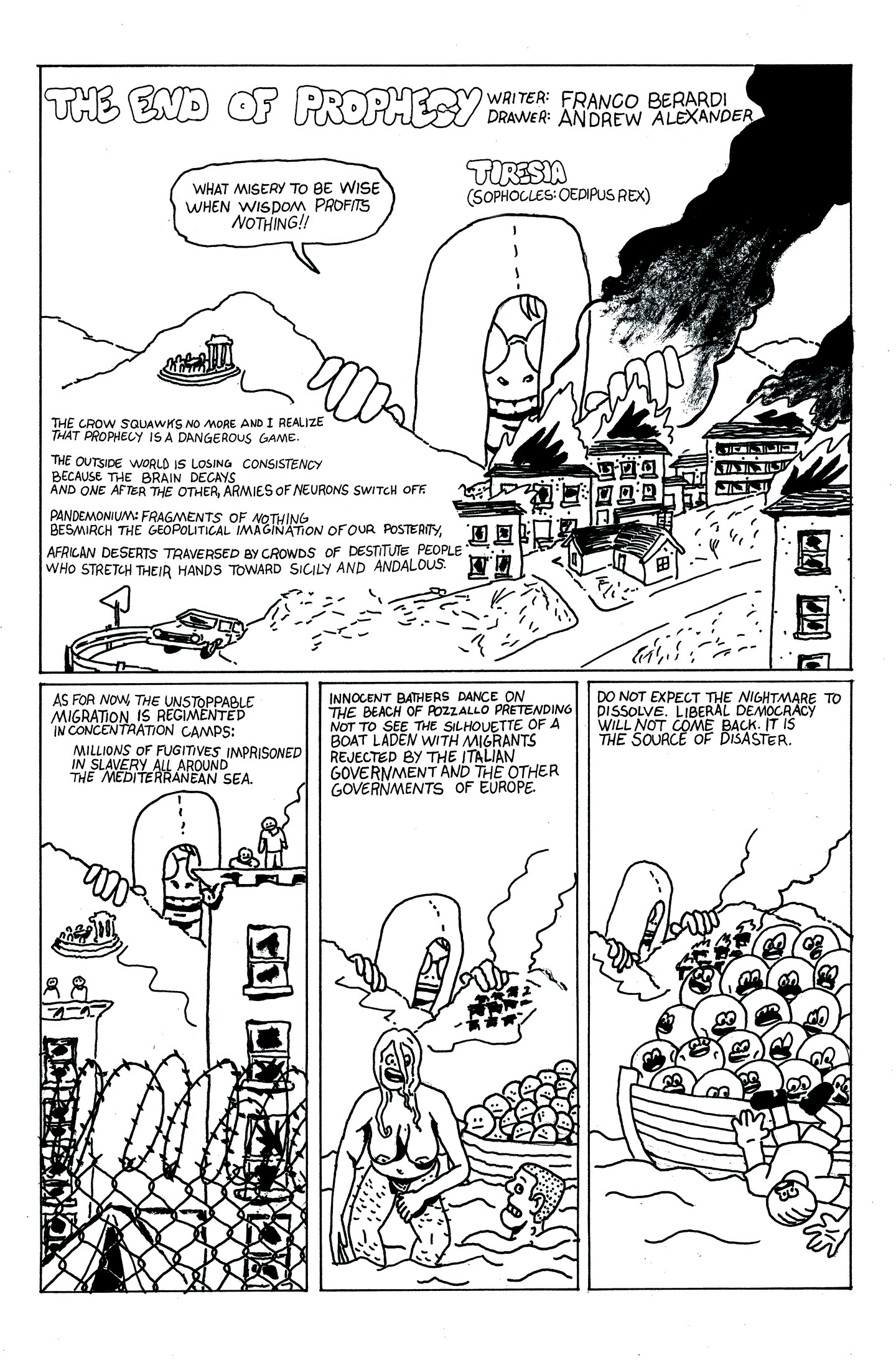The Border Crossing Us
Viewpoint Magazine November 7, 2018
Ultimately, no doubt, the left in the United States will have to confront the fact that there is never likely to be an ‘American revolution’ as classically imagined by DeLeon, Debs or Cannon. If socialism is to arrive one day in North America, it is far more probable that it will be by virtue of a combined, hemispheric process of revolt that overlaps boundaries and interlaces movements.
— Mike Davis, Prisoners of the American Dream: Politics and Economy in the History of the US Working Class1
After two weeks of arduous travel from Honduras, passing through Guatemala, and into southern Mexico, members of the migrant caravan received an offer from the Mexican government: opt to stay in Chiapas or Oaxaca, the two southernmost states of Mexico, where they would be eligible for entry into a temporary work program, with a regularization of migration status that would allow access to other benefits like healthcare, education, and mobility within those states. The plan, called Estás en Tu Casa [You’re at Home], was part of a larger régime of Central American migration management that Mexico has carried out in recent years with the support of the United States. The caravan, which at its height comprised more than 7,000 travellers from Honduras, El Salvador, Guatemala, and southern Mexico itself, was only the most recent and visible instance of larger process that we may read as a geographical displacement of the U.S. border to the south via the Mexican state.
The people travelling in the caravan, however, rejected the offer with a collective vote. The organization Pueblo Sin Fronteras, which is providing support to the caravan, posted a statement on its Facebook page: “Today at 6:35 pm on October 26, 2018, an assembly of the majority of members of the Caminata Migrante [Migrant Caravan] gathered in the Central Park of Arraiga and responded to the ‘Estás en Tu Casa’ Plan that the [Mexican] President announced today.” After enumerating the reasons for rejecting it, including the geographical limitations of the plan, the fact that it does not address the root causes for the Central American exodus, and a pattern of harassment by Mexican immigration authorities, the document concludes:We call on the hospitality of the communities we pass through. The members of the Caminata Migrante depend on the support and solidarity of the Mexican population, since the Government’s response has been more repressive than humanitarian. We also call on civil society, on human rights organizations, and on people in general to be alert and watch our path to avoid, monitor and condemn any abuse or harassment against members of this exodus and those who accompany it.
And people are watching. Despite the fact that migrants have been making the same journey for years, with 41,760 Hondurans making the trek into Mexico between January and September of this year, the caravan appears to illustrate something novel. On the one hand, the caravan’s visibility is in part a product of its centrality to the Republican Party’s closing strategy in the U.S. midterm elections: Donald Trump seized on the caravan after news of its pressing through the Guatemalan and Mexican borders, evidently hoping to turn fears about migration into votes in a context when right-wing violence has been dominating the news. On the other hand, however, this visibility was part of the migrants’ strategy of forming a caravan in the first place, an act that spectacularized and collectivized what for many has been a very dangerous, expensive, and often solitary journey overland through Mexico to arrive at the United States. This strategy, incidentally, has already caught on, two more caravans of nearly 2,000 people having formed in its wake. As their announcement concludes, the caravan strategy is predicated on the hope that the attention of others – the populations of the world and not the governments – will ultimately provide a measure of safety.
In the United States, any public response will have to contend with Trump’s rhetoric of invasion, war, and border militarization. Also notable, however, is the lack of any substantive response by the Democratic Party. Having decided to focus on healthcare for the midterms, Democrats have apparently not even responded to Trump’s threats of emergency measures intended to prevent those travelling in the caravan from making entry. These include a Muslim Ban-style suspension of all entry at the U.S.–Mexico border; the deployment of more than 5,000 troops to the border already, with 2,000 or so planned in coming days, and a projected total of 15,000 (more than the United States has deployed to Iraq or Afghanistan); the potential violation of the Posse Comitatus Act of 1878 (which restricts the use of military forces to enforce domestic policy); and a set of armed training exercises designed for media spectacle and to provide those pointlessly deployed troops with something to occupy their time. Yet even if these actions are more GOTV mobilizing devices than anything else, the Democratic silence is symptomatic of the fact that that party has little interest in an alternative position on immigration, since they live in fear of losing centrist voters who are supposed to have reasonable objections to the idea of an open border. Thus, even as the DHS Secretary says, “You will not get in” – disregarding the fact that, at a minimum, people in the caravan have claims to refugee status that the United States is bound by international law to entertain – the Democrats would rather avoid the topic.
The response by the U.S. right is predictable; nativism, as both public policy and private violence, is a crowning feature of contemporary reaction. The response by the Democratic politicians, for anyone who has followed their positions on immigration over the last half century, is also unsurprising. But that these policies are routine should not blunt urgency of radically different response to the caravan; what is utterly necessary is an internationalist position, a central feature of any strategy that hopes to rout barbarisms’ worldwide advance.
If we step outside media narratives, think beyond the immediate electoral horizon, and train our sights on migrant organizing and solidarity, the basis for such a politics becomes demonstrably clearer. Just as the right’s strategy of white fear-mongering has highlighted new, more visible tactics among migrants in the form of the caravan, we propose to respond by centering migrant struggles, particularly from the perspective of “migrant autonomy” that was so well-illustrated by the democratic decision-making of caravan members over their collective fate. With this perspective, it becomes evident that to consider class politics in the United States today means considering a working class whose composition crosses geographical borders and weaves together the exploited and the dispossessed from across a much broader region.
In the first place, migration requires us to adjust the scope of and displace our perspectives on the recent history of the U.S. left, in order to read its political make-up and the dynamic of its cycles of contention by following a different thread, seeking a different entry-point. The “New American Left” has indeed been given many beginnings: in Seattle 1999, the crestfallen streets at the start of the Iraq War, the crisis of 2008, the student movements of the following year, or Occupy in the autumn of 2011. This list would be incomplete, however, without any number of the powerful “border struggles” over the same period.
The Day Without an Immigrant strikes, or el gran paro estadounidense, were the largest work-stoppages to date in U.S. history, initiating new organizational forms and processes that are still underway in places like Chicago and Los Angeles. When the Obama administration followed these actions with the largest sweep of deportations in the country’s history, migrant struggle didn’t recede, but took on new forms: it animated student protests, including those ostensibly about austerity and privatization; it became a reference point in shop floor organizing amongst migrants in diverse sectors; hunger strikes, riots, and work stoppages in detention centers have been an underreported but crucial part of the escalating fight against prison conditions. Even the two most spectacular and pointed direct actions during the Trump presidency have been border struggles: the airport protests (and accompanying taxi strike) of 2016, and the more recent ICE blockades and emerging sanctuary movement. And furthermore, the most successful of the many general strike calls that came in the first few months of the Trump administration was precisely the one that received the most scant coverage in even left media: the migrant-led actions in the Midwest and South, which reflected the changing geography of immigrant labor in the United States. Why are these actions so rarely foregrounded – or frankly, even mentioned – when we discuss the prospects for anti-capitalist politics? What would it mean to remap our latest political cycle with these struggles in the lead?
The key insight of the “autonomy of migration” theoretical perspective, which has emerged within academic literature through discussions and political collaborations between European theorists, U.S. sociologists, and scholar-activists from the global South, is to see migrants themselves as active subjects whose mobility has definite political implications. The point is not to romanticize migration – migration, we know, is often anything but beautiful – or to impute immediate revolutionary motives to all who take on such journeys. Instead, it’s to take some distance from a detached sociology which would make migrants mere objects of market forces being passively “pushed” from one country, the so-called sending country, and “pulled” to another, the so-called receiving country.
It’s also distinct from a kind of liberal humanitarianism that might merely view migrants as symptoms of capitalism’s moral failings. While economic and moral factors may be at play, migration as a contemporary phenomenon is “paradigmatic” of capitalism’s relations of exploitation, and not only insofar as it illustrates the power of markets. Today’s migration points to the multiple forms of exploitation and dispossession that define the contemporary working class: from the corporate land grabs, climate change, and state violence that make subsistence farming impossible to the ways that the drug trade, finance, and the “migration industry” are able to extract surplus independently of the wage and, in the process, make life unliveable. Yet it also illustrates the active capacity of the working class to pose new forms of resistance to their subordination – or at least the conditions of their subordination – within and in relation to the labor process.2 In other words, workers may move to avoid specific working conditions, or to avoid being part of the industrial reserve army that otherwise sets the conditions of exploitation in a place like Honduras. In this sense, migration is autonomous because it is something conceptually and logically prior to the emergence of the state’s ever more extensive biopolitical and disciplinary border and labor management techniques. These techniques don’t simply seek to stop migrant flows, but actually use migrant flows to further segment and structure labor markets along the migrant trail in the countries of origin, reception, and those crossed along the way.
The régime of migrant “illegality,” for instance, segments the U.S. domestic labor market, and by extension, its workforce. Some workers are subjected to inferior labor contracts that are enforceable, at least in part, via a looming threat of deportation resulting from legal precarity by design. But ultimately the historical structuring of this category itself is a strategic response to the fact of a refusal by laborers in one context (the site of emigration) to accept their lot as what Michael Denning has called “the waste products of globalization.”3 It is, after all according to Marx, the double freedom of dispossession-cum-wage dependence which is the defining feature of the working class and in this sense these individuals partaking in “the yearly proletarian globe-hopping of seasonal workers by steamship, railroad and automobile” or by “radical separation of airborne migration linked by years of remittances and phone calls,” should hold a pride of place as the very literal foot soldiers of the working class.4
In the case of Honduras, as in much of the history of modern Latin America, conditions of exploitation and class relations cannot be separated from the regional imperial power of American capital and the state. In a sense, then, the circuit of difficult working class conditions abroad and U.S.-domestic “illegality” can be seen as a connected set of devices to handle mobility itself, a permanent feature of labor’s autonomy, which the exploited have used as a form of resistance even in the most repressive labor regimes like plantation slavery.5 This transnational circuit reaches its apex in the reciprocal re-structuring of Central American labor markets via the creation of employment in, for example, call centers specifically for deported and returned migrants who have lived in the United States. The border and migration regimes of the capitalist state work not simply to repel migrants or flex national sovereignty but to find new opportunities for cheap labor, whether migrants are coming or going. The point is that migrants are coming and going; their agency is the basis for capital’s continually multiplying regimes of capture, and their movement is thus part of a class struggle.
But although the conjunctural specificity of heightened awareness of the caravana de migrantes is an obvious impetus for us to seize on the autonomy of migration now, we must also note that the border spectacle of thousands of people physically crossing the space of the border only does half of the work to explain the autonomy of migration. We also have to grapple with the ways it highlights mutations to the practice of border enforcement. Increasingly, policing the nation’s boundaries is hardly restrained to the physical edges of a country but rather is also inscribed within it, as well as projected projected beyond it, into territory ostensibly governed by other states. “Illegality” has become a favorite technology of global capital in extending the border beyond its geographical confines. It points to a proliferation of rebordering negotiations in the physical space of the border as in the differential labor contracts that have come to define the segmentation of American labor, as manifested in ghettoized barrios, migrant detention centers, and policies like California’s Proposition 187 or Arizona’s SB 1070 or HR4437. Seen in this way, migrant autonomy is a concept which links the “border spectacle” with the powerful domestic “border struggles” by highlighting a repertoire of tactics which also include assimilation into traditional modes of organized labor like the AFL-CIO, SEIU, and AFSCME, the so-called new migrant workers’ centers, and other forms of working class insurgence and sabotage. 6
The “autonomy of migration” perspective therefore poses a politics that stands at a remove from “the people” as a subject of electoral democracy, because migration is in itself a political challenge to state sovereignty, both in the act of border crossing and in the presence of those whom the state does not recognize or differentially includes. The partisan perspective within US politics can only seem to register the phenomenon of migration as a “border spectacle” in an instrumental way. This goes for both parties insofar as Democrats are only happy to respond when the most visibly repressive border control methods, like child-separation or blanket travel-bans, are posed by their political opponents. These spectacular moments of faux-compassion stand in contrast to the fact, much cited on the socialist left now, that among U.S. presidents Obama still holds the record for deportations. On the other hand, migration as an autonomous social movement, or a movement which poses a subject whose focus is obviously not—and cannot be—the electoral arena, suggests another political horizon altogether, in which mobility is a form of resistance and the basis for new subject positions within capitalism, considered in its global dimension.7 What Yann Moulier Boutang terms, in a pathbreaking work, the “anonymous, collective, continuous, and uncontainable force of defection” is thus not counterposed to class struggle, but a constitutive feature of it, with powerful structuring effects on class formation.8
The importance of this point is to say that today, in a similar way, we cannot view refugees and other migrants only through an apolitical lens, as their activity poses challenges for anyone interested in working class politics in the United States. What horizon does this perspective on the autonomy of migration open? What lines of hemispheric revolt can be traced through it? How might it alter our understandings of the tense relation between socialism and electoralism?
Continues: https://www.viewpointmag.com/2018/11/07 ... sm-arrive/





